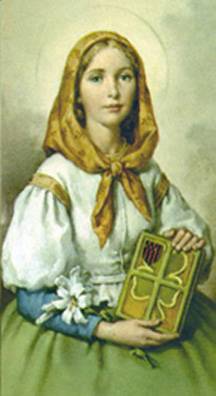|
Saint Dymphna
Feast day : 15 May

Today is the Feast of St. Dymphna who died at the young age of 15 years. She lived during the 7th century and was the daughter of a pagan king Damon in Ireland. Her mother was a devout Christian. At the young age of 14 years, she consecrated her life to Jesus and took a vow of chastity. Soon after her mother died and her father who loved his wife dearly was greatly distressed. His mental health began to deteriorate rapidly and all his counsellors advised him to remarry. He agreed to do so on one condition that his bride should be as beautiful as his deceased wife. They searched far and wide with no result. Soon on the evil advise of some of his counsellors, he began desiring his own daughter Dymphna who resembled her beautiful mother. As soon as she learnt of her father’s evil desire, she was determined to uphold her vow of chastity. She fled from her father’s palace alongwith her confessor Fr. Gerebernus, two trusted servants and the king’s fool. Together they set sail and reached Belgium. There they took refuge in the town of Geel.
Life in Geel:
Tradition has it that after they settled in Geel, Dymphna built a hospital for the poor and sick in that region and began serving them. But soon her father’s spies traced them to Belgium. Her father himself came to Geel to take back his daughter. He ordered his soldiers to kill the priest Fr. Gerebernus. Damon tried to persuade Dymphna to accompany him back to their home and marry him. When she refused, filled with anger, he drew his sword and struck off her head. She fell dead at his feet. Thus Fr. Gerebernus and Dymphna were martyred on the same day.
After Damon and his soldiers left, the residents of Geel gathered their remains and buried them in a nearby cave. Soon people with mental illnesses and infirmities began reporting cures when they prayed to her.
Sainthood:
She received the crown of martyrdom around the year 620 and became known as the ‘Lily of Eire’ due to her spotless virtue. In the 13th century, Guiard of Laon, Bishop of Cambrai commissioned an account of St. Dymphna’s life story based on the oral tradition and the miracles attributed to her in the centuries following her death. Her relics were placed in a church built in her honor in Gheel in the year 1349. Miraculous cures of mental illness, anxieties and epilepsy were reported at her shrine. Soon people from far and wide flocked to her shrine seeking her intervention in their needs. In the 15th century, the original St. Dymphna church was burned to the ground and a magnificent church of St. Dymphna was built and consecrated in 1532 where it stands till date. Her relics are placed in a silver reliquary in this church. Some of her remains were taken to United States and are kept at St. Mary’s Catholic Church in Massillon, Ohio.
Traditionally, Saint Dymphna is often portrayed with a crown on her head, dressed in royal robes, and holding a sword. In modern art, Saint Dymphna is shown holding the sword, which symbolizes her martyrdom, quite awkwardly. She is also often shown holding a lamp, while some holy cards feature her wearing green and white, holding a book and white lilies.
Prayers to Saint Dymphna: